Analysis of Huawei's Selling and Retail Management Strategies
VerifiedAdded on 2021/04/17
|16
|3806
|21
Report
AI Summary
This report provides a comprehensive analysis of Huawei's selling and retail management strategies. It begins with a business description of Huawei, including its telecommunications equipment production and its recent expansion into offline retail. The report then delves into customer analysis, examining market size and segmentation based on customer motivations. Competitive analysis is conducted using SWOT and PESTLE frameworks, followed by a discussion of Huawei's market penetration strategy, including branding and marketing mix. The report also explores the organization structure and HRM strategy of Huawei. The analysis reveals that Huawei is in a mature life cycle stage and faces intense competition. The report emphasizes the importance of service, innovative product design, and customer service to attract and retain customers. Finally, the report offers a conclusion summarizing the key findings and recommendations for Huawei's retail business.
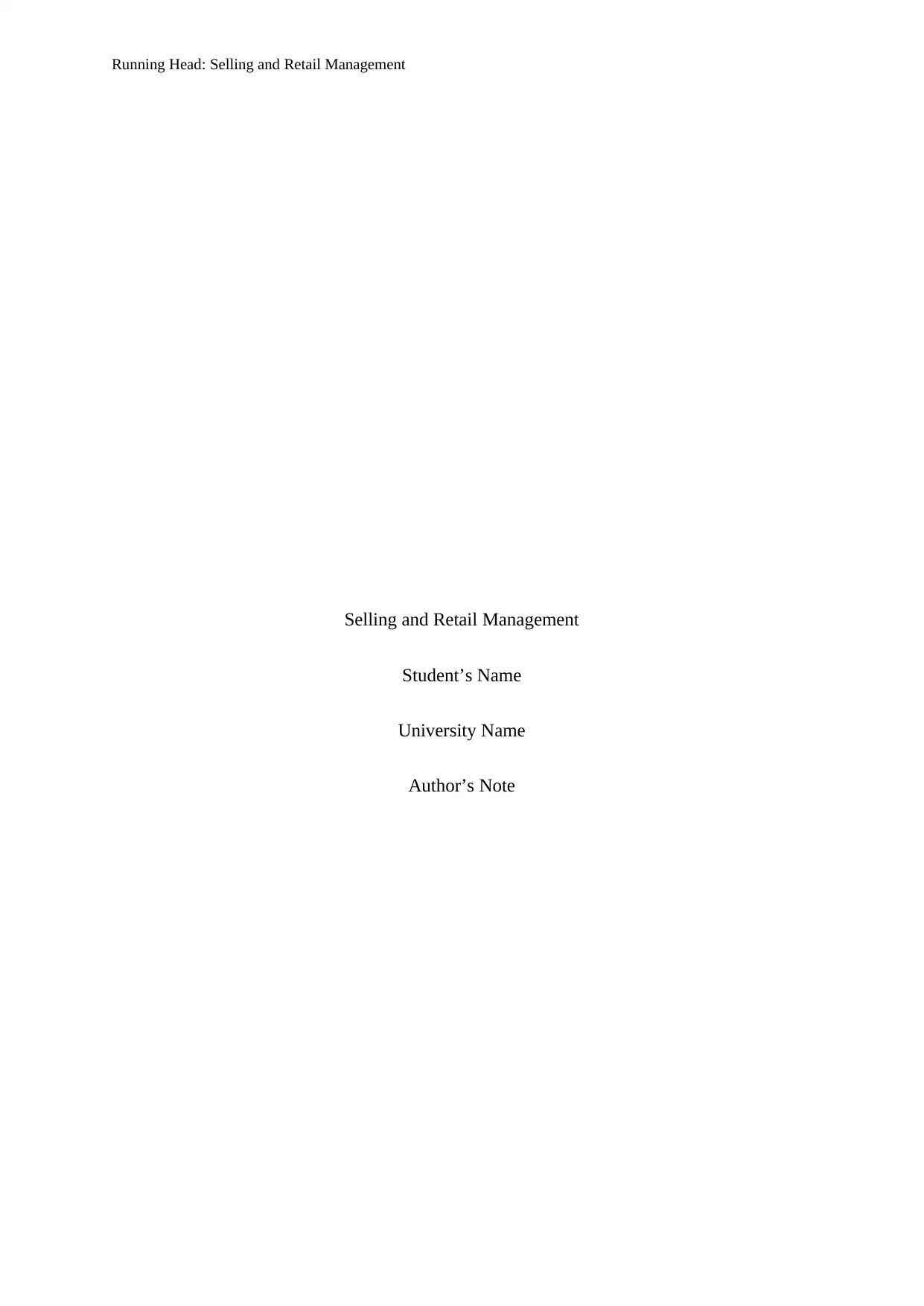
Running Head: Selling and Retail Management
Selling and Retail Management
Student’s Name
University Name
Author’s Note
Selling and Retail Management
Student’s Name
University Name
Author’s Note
Paraphrase This Document
Need a fresh take? Get an instant paraphrase of this document with our AI Paraphraser
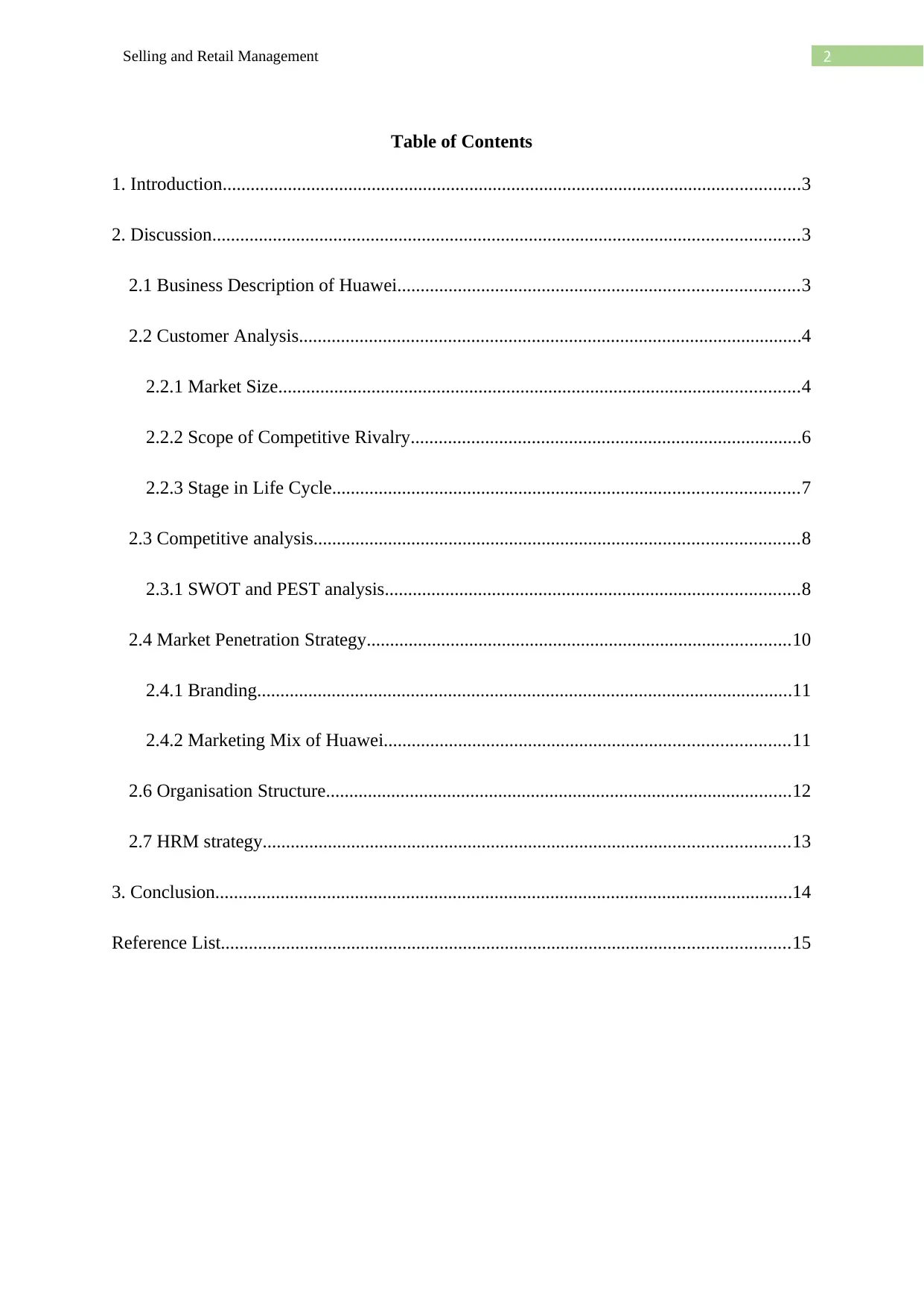
2Selling and Retail Management
Table of Contents
1. Introduction............................................................................................................................3
2. Discussion..............................................................................................................................3
2.1 Business Description of Huawei......................................................................................3
2.2 Customer Analysis............................................................................................................4
2.2.1 Market Size................................................................................................................4
2.2.2 Scope of Competitive Rivalry....................................................................................6
2.2.3 Stage in Life Cycle....................................................................................................7
2.3 Competitive analysis........................................................................................................8
2.3.1 SWOT and PEST analysis.........................................................................................8
2.4 Market Penetration Strategy...........................................................................................10
2.4.1 Branding...................................................................................................................11
2.4.2 Marketing Mix of Huawei.......................................................................................11
2.6 Organisation Structure....................................................................................................12
2.7 HRM strategy.................................................................................................................13
3. Conclusion............................................................................................................................14
Reference List..........................................................................................................................15
Table of Contents
1. Introduction............................................................................................................................3
2. Discussion..............................................................................................................................3
2.1 Business Description of Huawei......................................................................................3
2.2 Customer Analysis............................................................................................................4
2.2.1 Market Size................................................................................................................4
2.2.2 Scope of Competitive Rivalry....................................................................................6
2.2.3 Stage in Life Cycle....................................................................................................7
2.3 Competitive analysis........................................................................................................8
2.3.1 SWOT and PEST analysis.........................................................................................8
2.4 Market Penetration Strategy...........................................................................................10
2.4.1 Branding...................................................................................................................11
2.4.2 Marketing Mix of Huawei.......................................................................................11
2.6 Organisation Structure....................................................................................................12
2.7 HRM strategy.................................................................................................................13
3. Conclusion............................................................................................................................14
Reference List..........................................................................................................................15
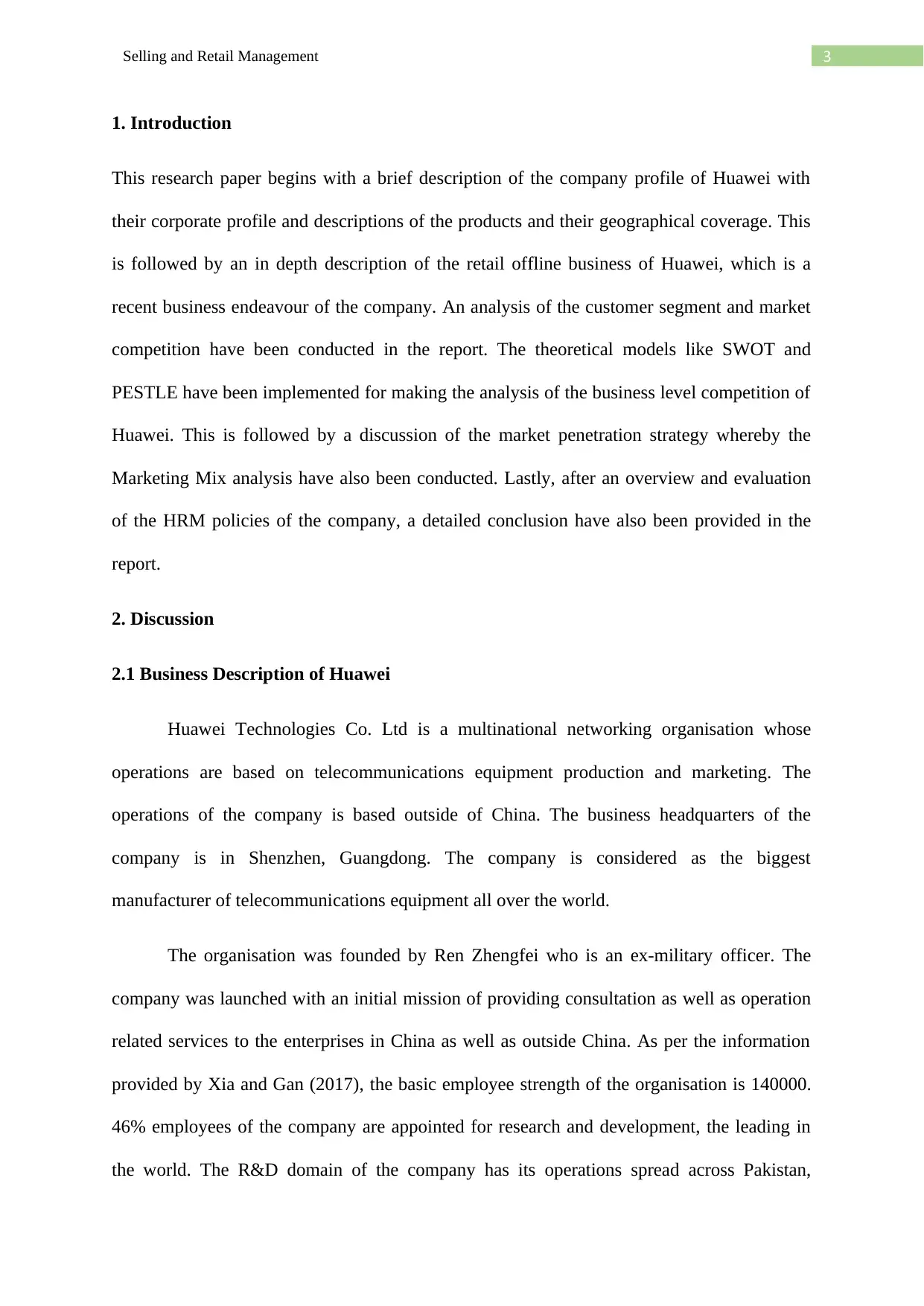
3Selling and Retail Management
1. Introduction
This research paper begins with a brief description of the company profile of Huawei with
their corporate profile and descriptions of the products and their geographical coverage. This
is followed by an in depth description of the retail offline business of Huawei, which is a
recent business endeavour of the company. An analysis of the customer segment and market
competition have been conducted in the report. The theoretical models like SWOT and
PESTLE have been implemented for making the analysis of the business level competition of
Huawei. This is followed by a discussion of the market penetration strategy whereby the
Marketing Mix analysis have also been conducted. Lastly, after an overview and evaluation
of the HRM policies of the company, a detailed conclusion have also been provided in the
report.
2. Discussion
2.1 Business Description of Huawei
Huawei Technologies Co. Ltd is a multinational networking organisation whose
operations are based on telecommunications equipment production and marketing. The
operations of the company is based outside of China. The business headquarters of the
company is in Shenzhen, Guangdong. The company is considered as the biggest
manufacturer of telecommunications equipment all over the world.
The organisation was founded by Ren Zhengfei who is an ex-military officer. The
company was launched with an initial mission of providing consultation as well as operation
related services to the enterprises in China as well as outside China. As per the information
provided by Xia and Gan (2017), the basic employee strength of the organisation is 140000.
46% employees of the company are appointed for research and development, the leading in
the world. The R&D domain of the company has its operations spread across Pakistan,
1. Introduction
This research paper begins with a brief description of the company profile of Huawei with
their corporate profile and descriptions of the products and their geographical coverage. This
is followed by an in depth description of the retail offline business of Huawei, which is a
recent business endeavour of the company. An analysis of the customer segment and market
competition have been conducted in the report. The theoretical models like SWOT and
PESTLE have been implemented for making the analysis of the business level competition of
Huawei. This is followed by a discussion of the market penetration strategy whereby the
Marketing Mix analysis have also been conducted. Lastly, after an overview and evaluation
of the HRM policies of the company, a detailed conclusion have also been provided in the
report.
2. Discussion
2.1 Business Description of Huawei
Huawei Technologies Co. Ltd is a multinational networking organisation whose
operations are based on telecommunications equipment production and marketing. The
operations of the company is based outside of China. The business headquarters of the
company is in Shenzhen, Guangdong. The company is considered as the biggest
manufacturer of telecommunications equipment all over the world.
The organisation was founded by Ren Zhengfei who is an ex-military officer. The
company was launched with an initial mission of providing consultation as well as operation
related services to the enterprises in China as well as outside China. As per the information
provided by Xia and Gan (2017), the basic employee strength of the organisation is 140000.
46% employees of the company are appointed for research and development, the leading in
the world. The R&D domain of the company has its operations spread across Pakistan,
⊘ This is a preview!⊘
Do you want full access?
Subscribe today to unlock all pages.

Trusted by 1+ million students worldwide
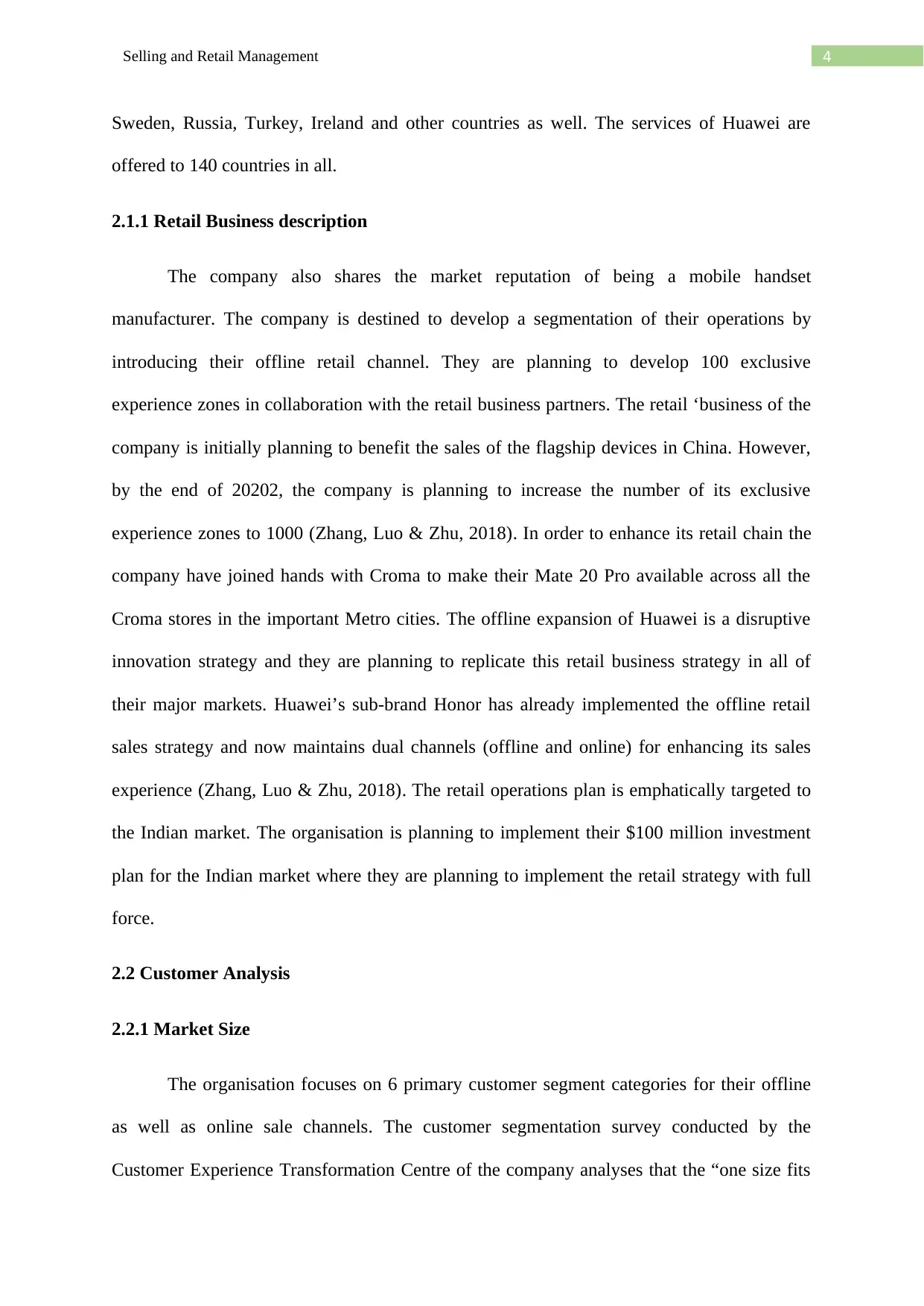
4Selling and Retail Management
Sweden, Russia, Turkey, Ireland and other countries as well. The services of Huawei are
offered to 140 countries in all.
2.1.1 Retail Business description
The company also shares the market reputation of being a mobile handset
manufacturer. The company is destined to develop a segmentation of their operations by
introducing their offline retail channel. They are planning to develop 100 exclusive
experience zones in collaboration with the retail business partners. The retail ‘business of the
company is initially planning to benefit the sales of the flagship devices in China. However,
by the end of 20202, the company is planning to increase the number of its exclusive
experience zones to 1000 (Zhang, Luo & Zhu, 2018). In order to enhance its retail chain the
company have joined hands with Croma to make their Mate 20 Pro available across all the
Croma stores in the important Metro cities. The offline expansion of Huawei is a disruptive
innovation strategy and they are planning to replicate this retail business strategy in all of
their major markets. Huawei’s sub-brand Honor has already implemented the offline retail
sales strategy and now maintains dual channels (offline and online) for enhancing its sales
experience (Zhang, Luo & Zhu, 2018). The retail operations plan is emphatically targeted to
the Indian market. The organisation is planning to implement their $100 million investment
plan for the Indian market where they are planning to implement the retail strategy with full
force.
2.2 Customer Analysis
2.2.1 Market Size
The organisation focuses on 6 primary customer segment categories for their offline
as well as online sale channels. The customer segmentation survey conducted by the
Customer Experience Transformation Centre of the company analyses that the “one size fits
Sweden, Russia, Turkey, Ireland and other countries as well. The services of Huawei are
offered to 140 countries in all.
2.1.1 Retail Business description
The company also shares the market reputation of being a mobile handset
manufacturer. The company is destined to develop a segmentation of their operations by
introducing their offline retail channel. They are planning to develop 100 exclusive
experience zones in collaboration with the retail business partners. The retail ‘business of the
company is initially planning to benefit the sales of the flagship devices in China. However,
by the end of 20202, the company is planning to increase the number of its exclusive
experience zones to 1000 (Zhang, Luo & Zhu, 2018). In order to enhance its retail chain the
company have joined hands with Croma to make their Mate 20 Pro available across all the
Croma stores in the important Metro cities. The offline expansion of Huawei is a disruptive
innovation strategy and they are planning to replicate this retail business strategy in all of
their major markets. Huawei’s sub-brand Honor has already implemented the offline retail
sales strategy and now maintains dual channels (offline and online) for enhancing its sales
experience (Zhang, Luo & Zhu, 2018). The retail operations plan is emphatically targeted to
the Indian market. The organisation is planning to implement their $100 million investment
plan for the Indian market where they are planning to implement the retail strategy with full
force.
2.2 Customer Analysis
2.2.1 Market Size
The organisation focuses on 6 primary customer segment categories for their offline
as well as online sale channels. The customer segmentation survey conducted by the
Customer Experience Transformation Centre of the company analyses that the “one size fits
Paraphrase This Document
Need a fresh take? Get an instant paraphrase of this document with our AI Paraphraser
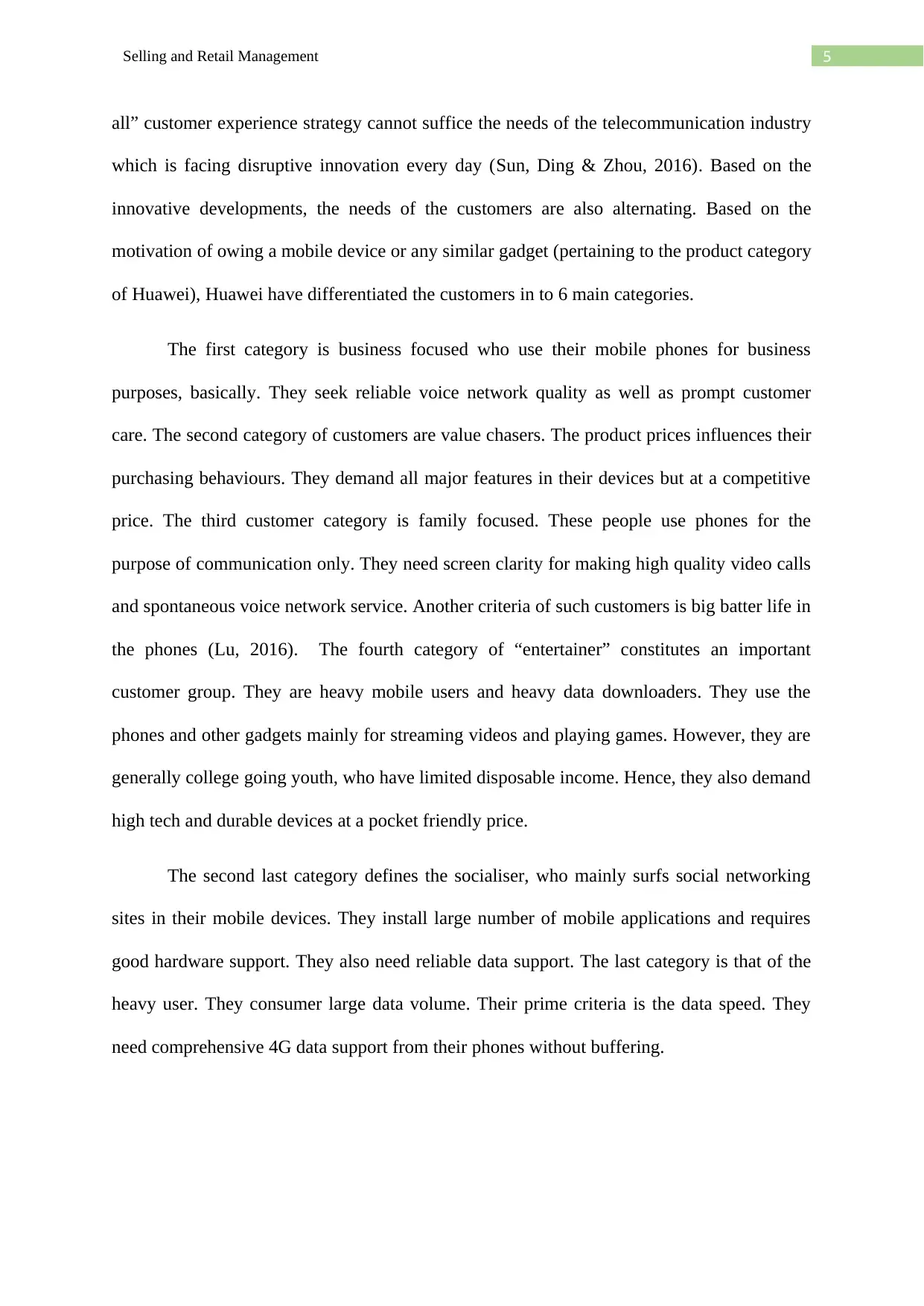
5Selling and Retail Management
all” customer experience strategy cannot suffice the needs of the telecommunication industry
which is facing disruptive innovation every day (Sun, Ding & Zhou, 2016). Based on the
innovative developments, the needs of the customers are also alternating. Based on the
motivation of owing a mobile device or any similar gadget (pertaining to the product category
of Huawei), Huawei have differentiated the customers in to 6 main categories.
The first category is business focused who use their mobile phones for business
purposes, basically. They seek reliable voice network quality as well as prompt customer
care. The second category of customers are value chasers. The product prices influences their
purchasing behaviours. They demand all major features in their devices but at a competitive
price. The third customer category is family focused. These people use phones for the
purpose of communication only. They need screen clarity for making high quality video calls
and spontaneous voice network service. Another criteria of such customers is big batter life in
the phones (Lu, 2016). The fourth category of “entertainer” constitutes an important
customer group. They are heavy mobile users and heavy data downloaders. They use the
phones and other gadgets mainly for streaming videos and playing games. However, they are
generally college going youth, who have limited disposable income. Hence, they also demand
high tech and durable devices at a pocket friendly price.
The second last category defines the socialiser, who mainly surfs social networking
sites in their mobile devices. They install large number of mobile applications and requires
good hardware support. They also need reliable data support. The last category is that of the
heavy user. They consumer large data volume. Their prime criteria is the data speed. They
need comprehensive 4G data support from their phones without buffering.
all” customer experience strategy cannot suffice the needs of the telecommunication industry
which is facing disruptive innovation every day (Sun, Ding & Zhou, 2016). Based on the
innovative developments, the needs of the customers are also alternating. Based on the
motivation of owing a mobile device or any similar gadget (pertaining to the product category
of Huawei), Huawei have differentiated the customers in to 6 main categories.
The first category is business focused who use their mobile phones for business
purposes, basically. They seek reliable voice network quality as well as prompt customer
care. The second category of customers are value chasers. The product prices influences their
purchasing behaviours. They demand all major features in their devices but at a competitive
price. The third customer category is family focused. These people use phones for the
purpose of communication only. They need screen clarity for making high quality video calls
and spontaneous voice network service. Another criteria of such customers is big batter life in
the phones (Lu, 2016). The fourth category of “entertainer” constitutes an important
customer group. They are heavy mobile users and heavy data downloaders. They use the
phones and other gadgets mainly for streaming videos and playing games. However, they are
generally college going youth, who have limited disposable income. Hence, they also demand
high tech and durable devices at a pocket friendly price.
The second last category defines the socialiser, who mainly surfs social networking
sites in their mobile devices. They install large number of mobile applications and requires
good hardware support. They also need reliable data support. The last category is that of the
heavy user. They consumer large data volume. Their prime criteria is the data speed. They
need comprehensive 4G data support from their phones without buffering.
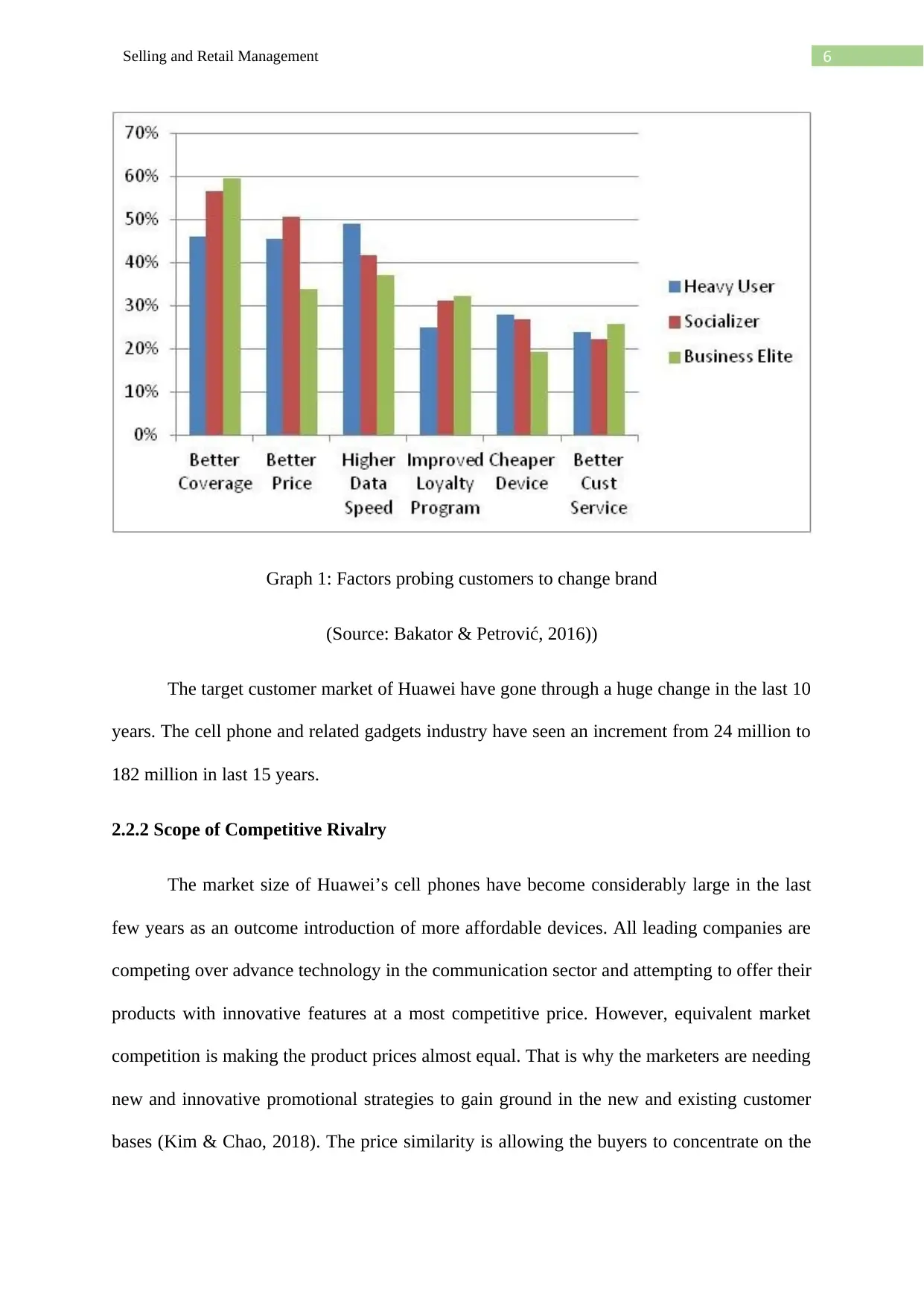
6Selling and Retail Management
Graph 1: Factors probing customers to change brand
(Source: Bakator & Petrović, 2016))
The target customer market of Huawei have gone through a huge change in the last 10
years. The cell phone and related gadgets industry have seen an increment from 24 million to
182 million in last 15 years.
2.2.2 Scope of Competitive Rivalry
The market size of Huawei’s cell phones have become considerably large in the last
few years as an outcome introduction of more affordable devices. All leading companies are
competing over advance technology in the communication sector and attempting to offer their
products with innovative features at a most competitive price. However, equivalent market
competition is making the product prices almost equal. That is why the marketers are needing
new and innovative promotional strategies to gain ground in the new and existing customer
bases (Kim & Chao, 2018). The price similarity is allowing the buyers to concentrate on the
Graph 1: Factors probing customers to change brand
(Source: Bakator & Petrović, 2016))
The target customer market of Huawei have gone through a huge change in the last 10
years. The cell phone and related gadgets industry have seen an increment from 24 million to
182 million in last 15 years.
2.2.2 Scope of Competitive Rivalry
The market size of Huawei’s cell phones have become considerably large in the last
few years as an outcome introduction of more affordable devices. All leading companies are
competing over advance technology in the communication sector and attempting to offer their
products with innovative features at a most competitive price. However, equivalent market
competition is making the product prices almost equal. That is why the marketers are needing
new and innovative promotional strategies to gain ground in the new and existing customer
bases (Kim & Chao, 2018). The price similarity is allowing the buyers to concentrate on the
⊘ This is a preview!⊘
Do you want full access?
Subscribe today to unlock all pages.

Trusted by 1+ million students worldwide
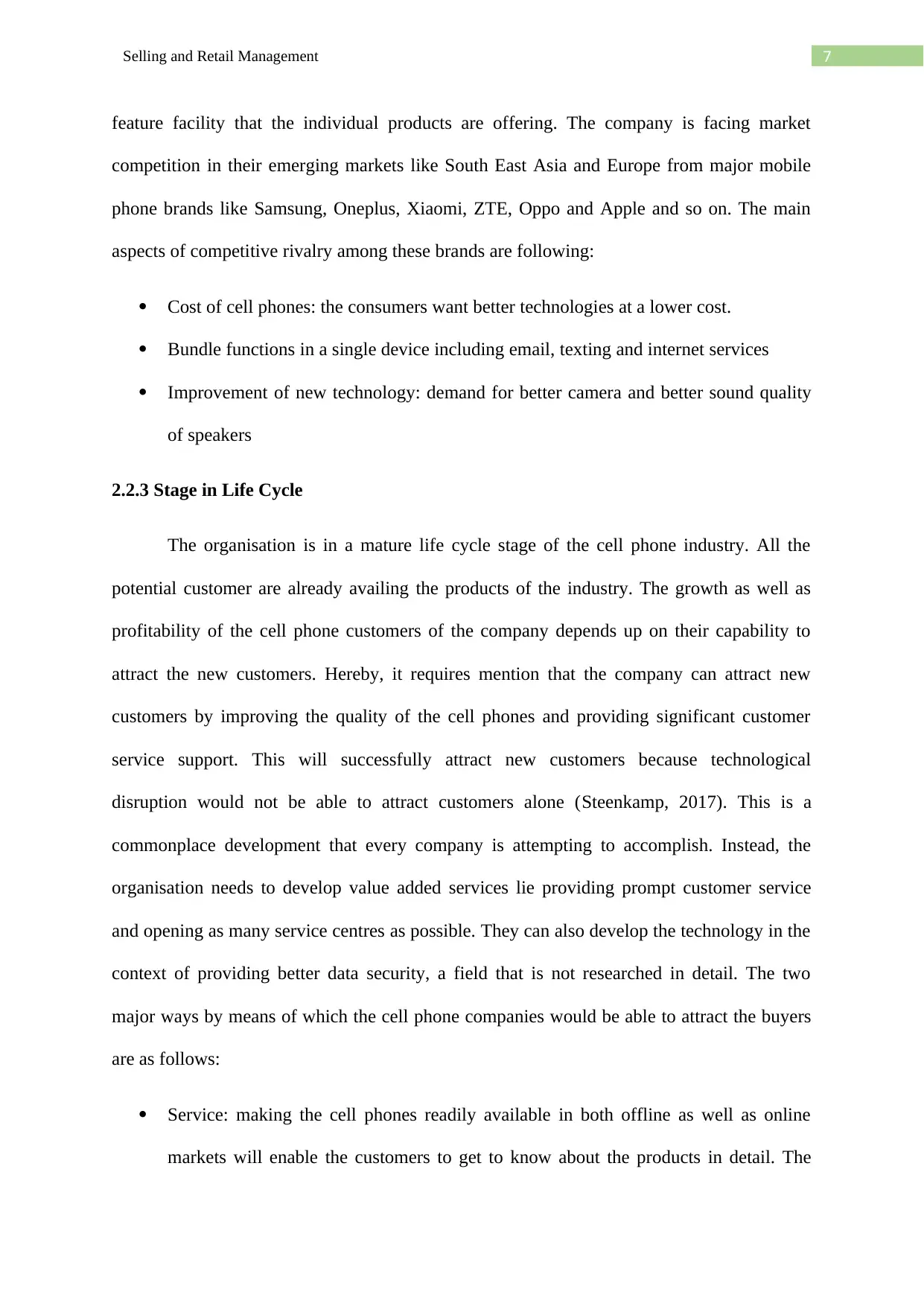
7Selling and Retail Management
feature facility that the individual products are offering. The company is facing market
competition in their emerging markets like South East Asia and Europe from major mobile
phone brands like Samsung, Oneplus, Xiaomi, ZTE, Oppo and Apple and so on. The main
aspects of competitive rivalry among these brands are following:
Cost of cell phones: the consumers want better technologies at a lower cost.
Bundle functions in a single device including email, texting and internet services
Improvement of new technology: demand for better camera and better sound quality
of speakers
2.2.3 Stage in Life Cycle
The organisation is in a mature life cycle stage of the cell phone industry. All the
potential customer are already availing the products of the industry. The growth as well as
profitability of the cell phone customers of the company depends up on their capability to
attract the new customers. Hereby, it requires mention that the company can attract new
customers by improving the quality of the cell phones and providing significant customer
service support. This will successfully attract new customers because technological
disruption would not be able to attract customers alone (Steenkamp, 2017). This is a
commonplace development that every company is attempting to accomplish. Instead, the
organisation needs to develop value added services lie providing prompt customer service
and opening as many service centres as possible. They can also develop the technology in the
context of providing better data security, a field that is not researched in detail. The two
major ways by means of which the cell phone companies would be able to attract the buyers
are as follows:
Service: making the cell phones readily available in both offline as well as online
markets will enable the customers to get to know about the products in detail. The
feature facility that the individual products are offering. The company is facing market
competition in their emerging markets like South East Asia and Europe from major mobile
phone brands like Samsung, Oneplus, Xiaomi, ZTE, Oppo and Apple and so on. The main
aspects of competitive rivalry among these brands are following:
Cost of cell phones: the consumers want better technologies at a lower cost.
Bundle functions in a single device including email, texting and internet services
Improvement of new technology: demand for better camera and better sound quality
of speakers
2.2.3 Stage in Life Cycle
The organisation is in a mature life cycle stage of the cell phone industry. All the
potential customer are already availing the products of the industry. The growth as well as
profitability of the cell phone customers of the company depends up on their capability to
attract the new customers. Hereby, it requires mention that the company can attract new
customers by improving the quality of the cell phones and providing significant customer
service support. This will successfully attract new customers because technological
disruption would not be able to attract customers alone (Steenkamp, 2017). This is a
commonplace development that every company is attempting to accomplish. Instead, the
organisation needs to develop value added services lie providing prompt customer service
and opening as many service centres as possible. They can also develop the technology in the
context of providing better data security, a field that is not researched in detail. The two
major ways by means of which the cell phone companies would be able to attract the buyers
are as follows:
Service: making the cell phones readily available in both offline as well as online
markets will enable the customers to get to know about the products in detail. The
Paraphrase This Document
Need a fresh take? Get an instant paraphrase of this document with our AI Paraphraser
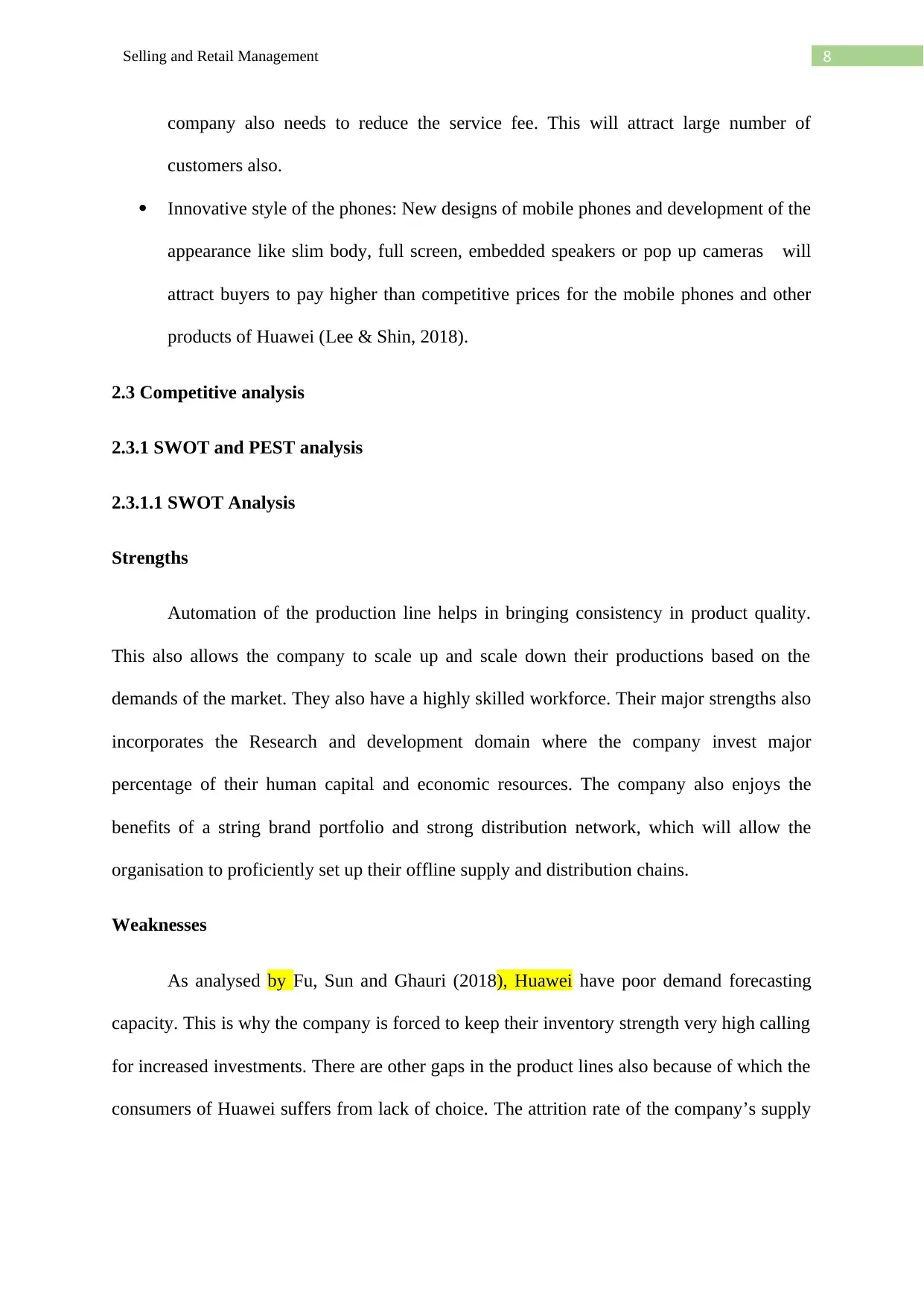
8Selling and Retail Management
company also needs to reduce the service fee. This will attract large number of
customers also.
Innovative style of the phones: New designs of mobile phones and development of the
appearance like slim body, full screen, embedded speakers or pop up cameras will
attract buyers to pay higher than competitive prices for the mobile phones and other
products of Huawei (Lee & Shin, 2018).
2.3 Competitive analysis
2.3.1 SWOT and PEST analysis
2.3.1.1 SWOT Analysis
Strengths
Automation of the production line helps in bringing consistency in product quality.
This also allows the company to scale up and scale down their productions based on the
demands of the market. They also have a highly skilled workforce. Their major strengths also
incorporates the Research and development domain where the company invest major
percentage of their human capital and economic resources. The company also enjoys the
benefits of a string brand portfolio and strong distribution network, which will allow the
organisation to proficiently set up their offline supply and distribution chains.
Weaknesses
As analysed by Fu, Sun and Ghauri (2018), Huawei have poor demand forecasting
capacity. This is why the company is forced to keep their inventory strength very high calling
for increased investments. There are other gaps in the product lines also because of which the
consumers of Huawei suffers from lack of choice. The attrition rate of the company’s supply
company also needs to reduce the service fee. This will attract large number of
customers also.
Innovative style of the phones: New designs of mobile phones and development of the
appearance like slim body, full screen, embedded speakers or pop up cameras will
attract buyers to pay higher than competitive prices for the mobile phones and other
products of Huawei (Lee & Shin, 2018).
2.3 Competitive analysis
2.3.1 SWOT and PEST analysis
2.3.1.1 SWOT Analysis
Strengths
Automation of the production line helps in bringing consistency in product quality.
This also allows the company to scale up and scale down their productions based on the
demands of the market. They also have a highly skilled workforce. Their major strengths also
incorporates the Research and development domain where the company invest major
percentage of their human capital and economic resources. The company also enjoys the
benefits of a string brand portfolio and strong distribution network, which will allow the
organisation to proficiently set up their offline supply and distribution chains.
Weaknesses
As analysed by Fu, Sun and Ghauri (2018), Huawei have poor demand forecasting
capacity. This is why the company is forced to keep their inventory strength very high calling
for increased investments. There are other gaps in the product lines also because of which the
consumers of Huawei suffers from lack of choice. The attrition rate of the company’s supply
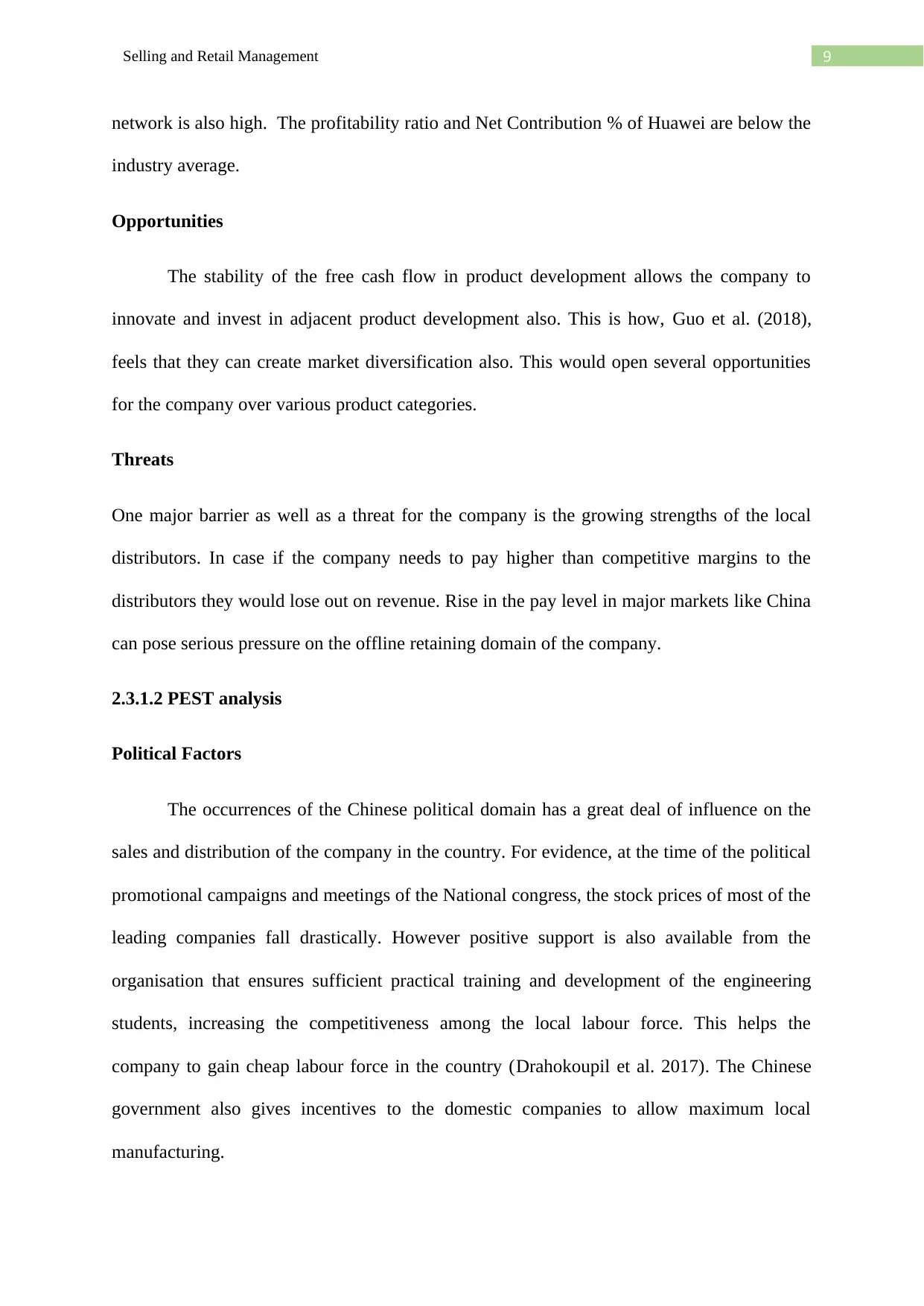
9Selling and Retail Management
network is also high. The profitability ratio and Net Contribution % of Huawei are below the
industry average.
Opportunities
The stability of the free cash flow in product development allows the company to
innovate and invest in adjacent product development also. This is how, Guo et al. (2018),
feels that they can create market diversification also. This would open several opportunities
for the company over various product categories.
Threats
One major barrier as well as a threat for the company is the growing strengths of the local
distributors. In case if the company needs to pay higher than competitive margins to the
distributors they would lose out on revenue. Rise in the pay level in major markets like China
can pose serious pressure on the offline retaining domain of the company.
2.3.1.2 PEST analysis
Political Factors
The occurrences of the Chinese political domain has a great deal of influence on the
sales and distribution of the company in the country. For evidence, at the time of the political
promotional campaigns and meetings of the National congress, the stock prices of most of the
leading companies fall drastically. However positive support is also available from the
organisation that ensures sufficient practical training and development of the engineering
students, increasing the competitiveness among the local labour force. This helps the
company to gain cheap labour force in the country (Drahokoupil et al. 2017). The Chinese
government also gives incentives to the domestic companies to allow maximum local
manufacturing.
network is also high. The profitability ratio and Net Contribution % of Huawei are below the
industry average.
Opportunities
The stability of the free cash flow in product development allows the company to
innovate and invest in adjacent product development also. This is how, Guo et al. (2018),
feels that they can create market diversification also. This would open several opportunities
for the company over various product categories.
Threats
One major barrier as well as a threat for the company is the growing strengths of the local
distributors. In case if the company needs to pay higher than competitive margins to the
distributors they would lose out on revenue. Rise in the pay level in major markets like China
can pose serious pressure on the offline retaining domain of the company.
2.3.1.2 PEST analysis
Political Factors
The occurrences of the Chinese political domain has a great deal of influence on the
sales and distribution of the company in the country. For evidence, at the time of the political
promotional campaigns and meetings of the National congress, the stock prices of most of the
leading companies fall drastically. However positive support is also available from the
organisation that ensures sufficient practical training and development of the engineering
students, increasing the competitiveness among the local labour force. This helps the
company to gain cheap labour force in the country (Drahokoupil et al. 2017). The Chinese
government also gives incentives to the domestic companies to allow maximum local
manufacturing.
⊘ This is a preview!⊘
Do you want full access?
Subscribe today to unlock all pages.

Trusted by 1+ million students worldwide
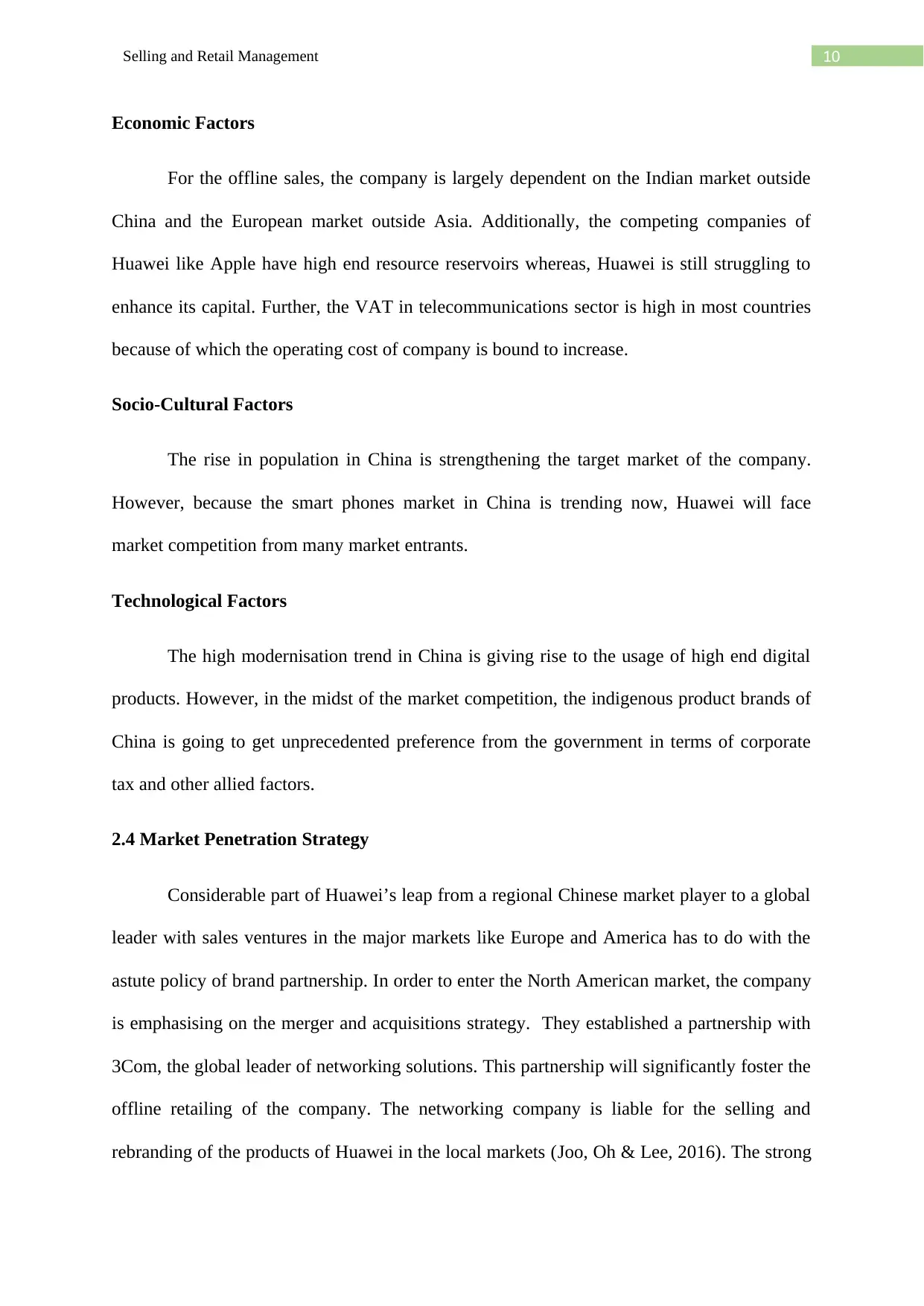
10Selling and Retail Management
Economic Factors
For the offline sales, the company is largely dependent on the Indian market outside
China and the European market outside Asia. Additionally, the competing companies of
Huawei like Apple have high end resource reservoirs whereas, Huawei is still struggling to
enhance its capital. Further, the VAT in telecommunications sector is high in most countries
because of which the operating cost of company is bound to increase.
Socio-Cultural Factors
The rise in population in China is strengthening the target market of the company.
However, because the smart phones market in China is trending now, Huawei will face
market competition from many market entrants.
Technological Factors
The high modernisation trend in China is giving rise to the usage of high end digital
products. However, in the midst of the market competition, the indigenous product brands of
China is going to get unprecedented preference from the government in terms of corporate
tax and other allied factors.
2.4 Market Penetration Strategy
Considerable part of Huawei’s leap from a regional Chinese market player to a global
leader with sales ventures in the major markets like Europe and America has to do with the
astute policy of brand partnership. In order to enter the North American market, the company
is emphasising on the merger and acquisitions strategy. They established a partnership with
3Com, the global leader of networking solutions. This partnership will significantly foster the
offline retailing of the company. The networking company is liable for the selling and
rebranding of the products of Huawei in the local markets (Joo, Oh & Lee, 2016). The strong
Economic Factors
For the offline sales, the company is largely dependent on the Indian market outside
China and the European market outside Asia. Additionally, the competing companies of
Huawei like Apple have high end resource reservoirs whereas, Huawei is still struggling to
enhance its capital. Further, the VAT in telecommunications sector is high in most countries
because of which the operating cost of company is bound to increase.
Socio-Cultural Factors
The rise in population in China is strengthening the target market of the company.
However, because the smart phones market in China is trending now, Huawei will face
market competition from many market entrants.
Technological Factors
The high modernisation trend in China is giving rise to the usage of high end digital
products. However, in the midst of the market competition, the indigenous product brands of
China is going to get unprecedented preference from the government in terms of corporate
tax and other allied factors.
2.4 Market Penetration Strategy
Considerable part of Huawei’s leap from a regional Chinese market player to a global
leader with sales ventures in the major markets like Europe and America has to do with the
astute policy of brand partnership. In order to enter the North American market, the company
is emphasising on the merger and acquisitions strategy. They established a partnership with
3Com, the global leader of networking solutions. This partnership will significantly foster the
offline retailing of the company. The networking company is liable for the selling and
rebranding of the products of Huawei in the local markets (Joo, Oh & Lee, 2016). The strong
Paraphrase This Document
Need a fresh take? Get an instant paraphrase of this document with our AI Paraphraser
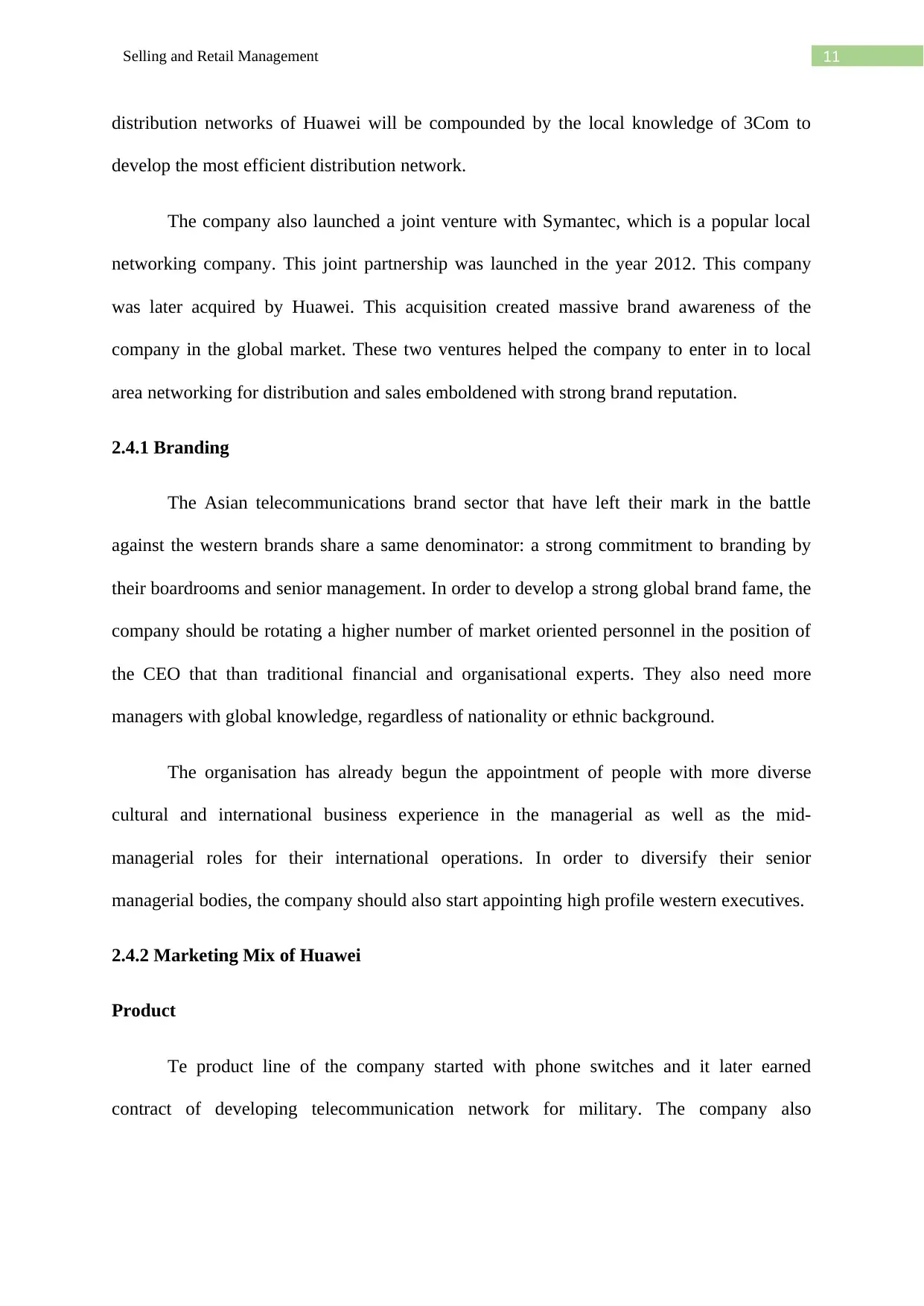
11Selling and Retail Management
distribution networks of Huawei will be compounded by the local knowledge of 3Com to
develop the most efficient distribution network.
The company also launched a joint venture with Symantec, which is a popular local
networking company. This joint partnership was launched in the year 2012. This company
was later acquired by Huawei. This acquisition created massive brand awareness of the
company in the global market. These two ventures helped the company to enter in to local
area networking for distribution and sales emboldened with strong brand reputation.
2.4.1 Branding
The Asian telecommunications brand sector that have left their mark in the battle
against the western brands share a same denominator: a strong commitment to branding by
their boardrooms and senior management. In order to develop a strong global brand fame, the
company should be rotating a higher number of market oriented personnel in the position of
the CEO that than traditional financial and organisational experts. They also need more
managers with global knowledge, regardless of nationality or ethnic background.
The organisation has already begun the appointment of people with more diverse
cultural and international business experience in the managerial as well as the mid-
managerial roles for their international operations. In order to diversify their senior
managerial bodies, the company should also start appointing high profile western executives.
2.4.2 Marketing Mix of Huawei
Product
Te product line of the company started with phone switches and it later earned
contract of developing telecommunication network for military. The company also
distribution networks of Huawei will be compounded by the local knowledge of 3Com to
develop the most efficient distribution network.
The company also launched a joint venture with Symantec, which is a popular local
networking company. This joint partnership was launched in the year 2012. This company
was later acquired by Huawei. This acquisition created massive brand awareness of the
company in the global market. These two ventures helped the company to enter in to local
area networking for distribution and sales emboldened with strong brand reputation.
2.4.1 Branding
The Asian telecommunications brand sector that have left their mark in the battle
against the western brands share a same denominator: a strong commitment to branding by
their boardrooms and senior management. In order to develop a strong global brand fame, the
company should be rotating a higher number of market oriented personnel in the position of
the CEO that than traditional financial and organisational experts. They also need more
managers with global knowledge, regardless of nationality or ethnic background.
The organisation has already begun the appointment of people with more diverse
cultural and international business experience in the managerial as well as the mid-
managerial roles for their international operations. In order to diversify their senior
managerial bodies, the company should also start appointing high profile western executives.
2.4.2 Marketing Mix of Huawei
Product
Te product line of the company started with phone switches and it later earned
contract of developing telecommunication network for military. The company also
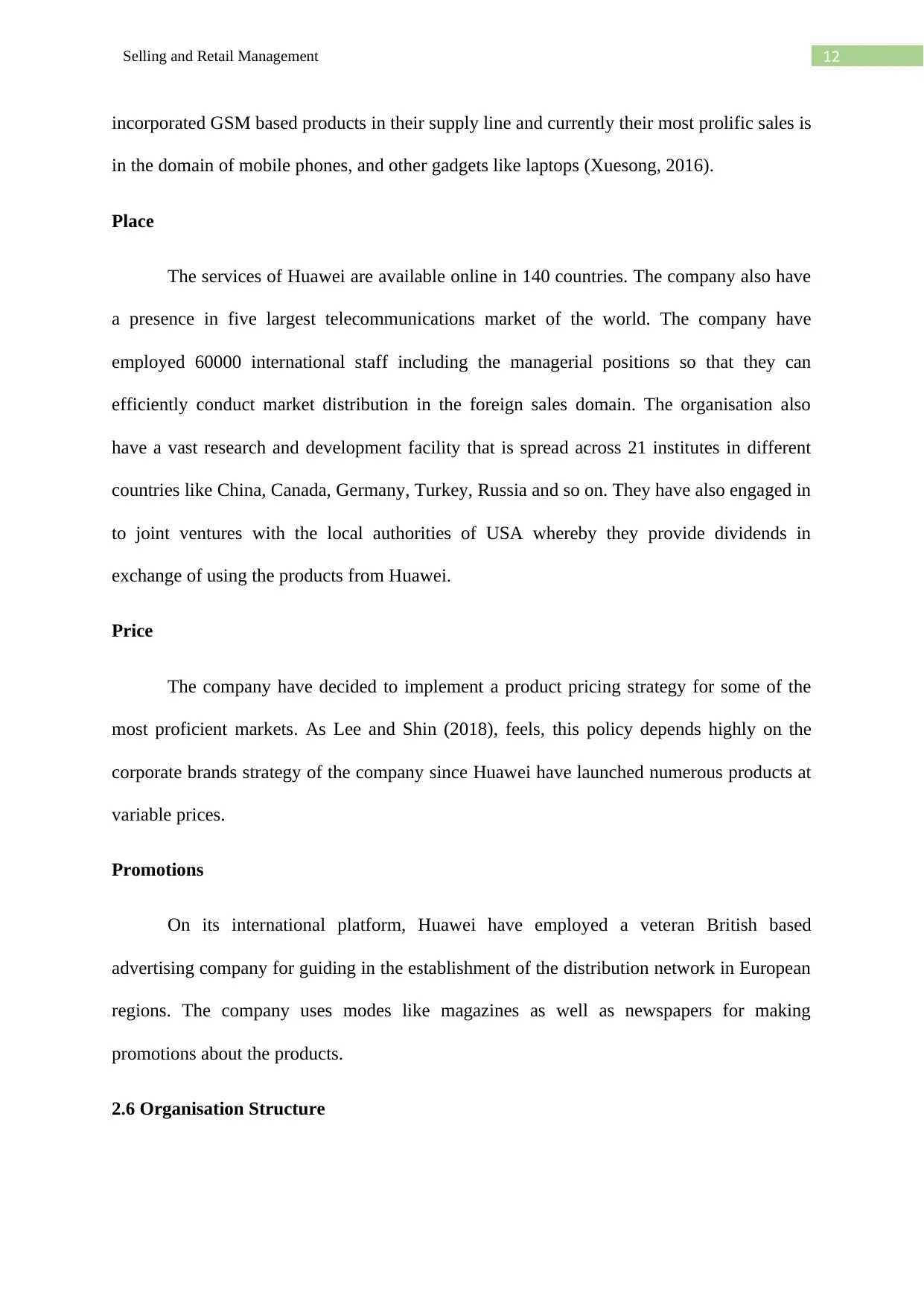
12Selling and Retail Management
incorporated GSM based products in their supply line and currently their most prolific sales is
in the domain of mobile phones, and other gadgets like laptops (Xuesong, 2016).
Place
The services of Huawei are available online in 140 countries. The company also have
a presence in five largest telecommunications market of the world. The company have
employed 60000 international staff including the managerial positions so that they can
efficiently conduct market distribution in the foreign sales domain. The organisation also
have a vast research and development facility that is spread across 21 institutes in different
countries like China, Canada, Germany, Turkey, Russia and so on. They have also engaged in
to joint ventures with the local authorities of USA whereby they provide dividends in
exchange of using the products from Huawei.
Price
The company have decided to implement a product pricing strategy for some of the
most proficient markets. As Lee and Shin (2018), feels, this policy depends highly on the
corporate brands strategy of the company since Huawei have launched numerous products at
variable prices.
Promotions
On its international platform, Huawei have employed a veteran British based
advertising company for guiding in the establishment of the distribution network in European
regions. The company uses modes like magazines as well as newspapers for making
promotions about the products.
2.6 Organisation Structure
incorporated GSM based products in their supply line and currently their most prolific sales is
in the domain of mobile phones, and other gadgets like laptops (Xuesong, 2016).
Place
The services of Huawei are available online in 140 countries. The company also have
a presence in five largest telecommunications market of the world. The company have
employed 60000 international staff including the managerial positions so that they can
efficiently conduct market distribution in the foreign sales domain. The organisation also
have a vast research and development facility that is spread across 21 institutes in different
countries like China, Canada, Germany, Turkey, Russia and so on. They have also engaged in
to joint ventures with the local authorities of USA whereby they provide dividends in
exchange of using the products from Huawei.
Price
The company have decided to implement a product pricing strategy for some of the
most proficient markets. As Lee and Shin (2018), feels, this policy depends highly on the
corporate brands strategy of the company since Huawei have launched numerous products at
variable prices.
Promotions
On its international platform, Huawei have employed a veteran British based
advertising company for guiding in the establishment of the distribution network in European
regions. The company uses modes like magazines as well as newspapers for making
promotions about the products.
2.6 Organisation Structure
⊘ This is a preview!⊘
Do you want full access?
Subscribe today to unlock all pages.

Trusted by 1+ million students worldwide
1 out of 16
Related Documents
Your All-in-One AI-Powered Toolkit for Academic Success.
+13062052269
info@desklib.com
Available 24*7 on WhatsApp / Email
![[object Object]](/_next/static/media/star-bottom.7253800d.svg)
Unlock your academic potential
Copyright © 2020–2025 A2Z Services. All Rights Reserved. Developed and managed by ZUCOL.





